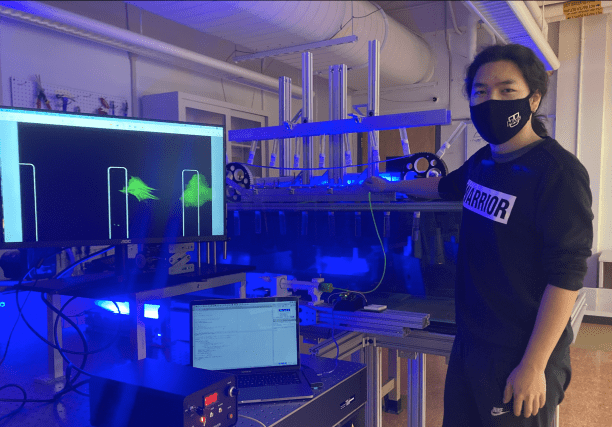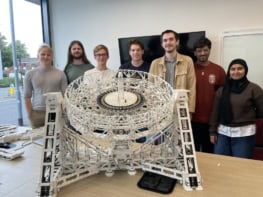
The emergence of a new variant of the coronavirus has put a constellation of researchers – virologists, immunologists and epidemiologists chief among them – in the hot seat as political leaders and public health experts seek answers to questions about how transmissible it is and whether it erodes pre-existing immunity. But while attention for the moment is on the life sciences, physicists also have a role to play in stopping the virus that causes COVID-19. Indeed, in the longer term, insights from physics could drastically reduce transmission of other respiratory pathogens, too.
Take social distancing. Signs asking people to keep 2 m (or 6 feet) away from others have become ubiquitous during the pandemic, and many shops have placed stickers on the floor at 2 m spacings to help safety-conscious consumers stay the requisite distance apart as they queue. But according to Varghese Mathai, a physicist at the University of Massachusetts Amherst in the US, these precautions are ineffective. In fact, they could even do more harm than good.
To evaluate the effects of 2m distancing in queues, Mathai, Ruixi Lou and Devin Kenney constructed a series of cylindrical dummies (a stand-in for queuing humans) spaced 6 feet apart, mounted it on a conveyor belt and placed it underwater (a stand-in for air, which is also a fluid). After filling an “infected” dummy with dye (representing virus-laden particles), they used a stepper motor to replicate the stop-start motion of people in a queue. The discomfiting result is that whenever the “queue” moved, each dummy ran straight into the cloud of dye emitted by the dummy in front of it, significantly reducing any benefit associated with distancing.
The Amherst team’s study did have some limitations. Notably, people’s breath tends to rise above their heads after they exhale, whereas the dye in the test tank did not. The conclusion, nevertheless, is that social distancing in queues is not an effective public health measure, even if the distance is doubled to 12 feet. “In both cases, you see that the released dye particles end up right in front of the person behind you,” Mathai told the audience at a press briefing held on 23 November, during the annual meeting of the American Physical Society’s Division of Fluid Dynamics (APS DFD). His verdict? “Waiting lines present a scenario where airborne transmission is possible.”
Masking up
If keeping your distance indoors isn’t an effective way of stopping the coronavirus, what is? The answer, in a word, is masks. On the same day as the briefing, Philippe Bourrianne of Princeton University and colleagues published a study in Physical Review Fluids on how masks change the airflow around a person as they exhale. The gist is that basic surgical facemasks tend to redirect the flow of exhalations upward, mitigating airborne disease transmission by keeping infectious particles out of the faces of other humans.

If that isn’t enough to protect people – and if the room is heated or cooled via vents blowing air down from the ceiling, it likely isn’t – the good news is that physics may have a solution. At a separate APS DFD briefing on 24 November that focused on the future of face masks, biomedical fluids engineer Saikat Basu described how he and his team at South Dakota State University are developing a new type of mask inspired by the convoluted nasal passages of dogs and other animals that have an excellent sense of smell. Their goal is to create a filter that is as effective as the material in a standard N95 mask, but much more breathable. “We are looking at a future where these respiratory pathogens will be more common,” Basu explained. Comfortable, effective masks are part of the solution, he added, because people will be more inclined to wear them.

Physics points the way to COVID-safe singing
During the same briefing, fluid mechanics researcher Tanya Purwar zeroed in on another flaw in today’s face masks: the tremendous amount of non-recyclable, non-biodegradable waste they generate. She and her colleagues at Purdue University have developed a reusable filter made from multiple layers of material: a hydrophobic and lipophobic outer layer to repel the virus and droplets that carry it; a non-woven layer; a copper layer coated with diamond-like carbon to inactivate any virus that makes it through; and finally two more non-woven layers for filtration and comfort near the mouth. Purwar explained that the point of making a filter, rather than a complete mask, is that they want it to be as flexible as possible to suit different face shapes and sizes. “This could have several applications – not just in a mask, but in air filtration systems, too,” she added.
Staying safe
Scientifically-informed public health measures, better masks, and ventilation systems that don’t create “dead zones” of uncirculated air or blow infectious particles around a room (the subject of a presentation by atmospheric scientist Rao Kotamarthi of Argonne National Laboratory) will all play a role in protecting people. As Purwar put it, “We’ve all been trying to come up with more efficient ways of staying safe from the virus.” The big question, though, is how long it will take to implement these solutions, and on that subject, Alfredo Soldati, a fluid mechanics expert at Technische Universität Wien, Austria, sounded a note of caution. Too often in the pandemic, he warned, “measures have been put in place where we could, not where we should”. Public health officials have a lot on their plates, but if they can spare some time to listen to their physics-trained colleagues, it could make their jobs – and all of our lives – much, much easier.



